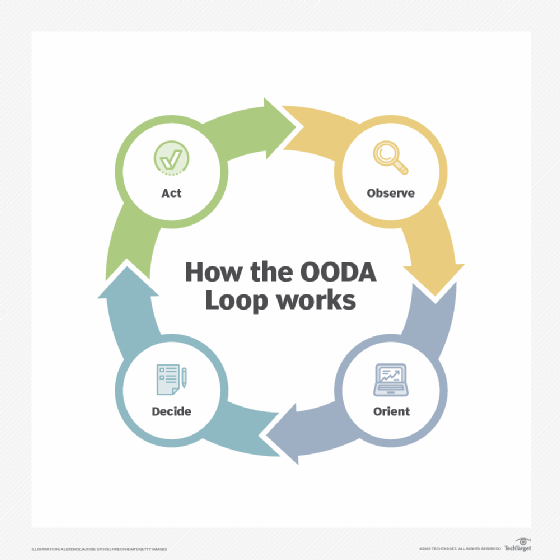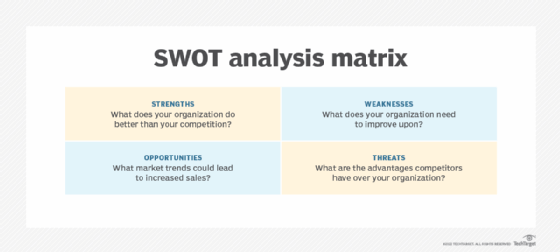
OODA loop
What is the OODA loop?
The OODA loop -- Observe, Orient, Decide and Act -- is a four-step approach to decision-making that focuses on filtering available information, putting it in context and quickly making the most appropriate decision, while also understanding that changes can be made as more data becomes available. The strategy is applicable at an individual level, as well as an organizational level. It is particularly useful in scenarios where competition is involved and where the ability to react to changing circumstances faster than an opponent can be advantageous.
Many modern environments can be described as volatile, uncertain, complex and ambiguous, or VUCA. Surviving and winning in this type of situation require an organization to make better decisions. However, improving the quality of decision-making is something many organizations have failed to do. For example, if a company continues to make choices that do not provide a positive return, they are failing to learn from their experiences. The OODA loop acknowledges this habit and provides an approach to help them make improvements.
Now applied to a variety of fields, the OODA loop was developed in the mid-20th century by military strategist and U.S. Air Force Colonel John Boyd. It was initially used to train soldiers to make time-sensitive decisions rapidly during air combat when they might not have time to gather information. The goal of the strategy was to execute the OODA loop process more quickly than an opponent to infiltrate and disrupt the enemy's decision cycle.
OODA loop-related terminology
Before the OODA loop can be fully understood, the following related concepts need to be introduced:
- Maneuver warfare. This is a strategy used in the military that emphasizes disrupting the enemy's decision-making skills to defeat them. Maneuver warfare revolves around surprise and deception. The concept of the OODA loop was derived from the strategy of maneuver warfare.
- Mental models. These are representations or explanations of human behavior that exist on a personal, internal level. A person can generate a mental model to understand their thought processes, decisions and consequences. Mental models are a part of the orientation step of the OODA loop.
- Situational awareness. This is the comprehension of all environmental stimuli. It involves perceiving all components of a situation, understanding what they mean and using them to make future judgements. Achieving situational awareness is crucial for most decision-making processes, including the OODA loop.
- Reaction time. This refers to the time that elapses between a stimulus and the response given to that stimulus. A primary goal in the OODA loop is to minimize an individual's or organization's reaction time.
How the OODA loop works: The 4 steps
Like other problem-solving methods, the OODA loop is an interactive, iterative process that entails analyzing results, noting any lessons learned and repeating the cycle in future scenarios. While the process is not always simple or linear, the following four separate steps involved are as follows:
- Observe. The first step is to identify the problem or threat and gain an overall understanding of the internal and external environment. In the corporate world, this can be equated to data gathering, where the company collects all the information regarding the current organizational state, any competitors and the market. The key point about the Observe step is recognizing that the world is complex. All data is a snapshot in time and must be treated as such. Therefore, entities must gather whatever information is available as quickly as possible and be prepared to make decisions based on it.
- Orient. The Orient phase involves reflecting on what has been found during observations and considering what should be done next. It requires a significant level of situational awareness and understanding to make a conscious decision. Since some decisions are unconscious or instinctual, this step involves considering what and why decisions are made prior to choosing a course of action. When applied on an individual level, the Orient step can be performed by creating mental models or mental rehearsal drills to place information into narratives that shape judgement. In organizational applications, situational models can be created with machine learning tools to identify potential outcomes, while removing any bias.
- Decide. The Decide phase makes suggestions toward an action or response plan, taking into consideration all potential outcomes. This can be accomplished through meetings or discussions that are focused on creating a roadmap for the entire organization.
- Act. Action pertains to carrying out the decision and related changes that need to be made in response to the decision. This step might also include any testing that is required before officially carrying out an action, such as compatibility or A/B testing.
These phases have been broken out for the purposes of explanation, but in some real-world scenarios, they might happen in a fraction of a second.

Success of the OODA loop
One key to the success of the OODA loop is to make it as short as possible, minimizing reaction times in high-stakes situations. In the OODA loop's simplest form, there is generally only one stimulus and one response, but that is not always the case. Hick's law can be applied to the reaction time of an OODA loop that has more than one stimulus or response: When there are multiple options available in response to a stimulus, reaction time is slowed down.
The ability to make decisions faster than an opponent is important, but it is not only about speed. Tempo -- frequency -- is also critical, as the ability to rapidly speed up and slow down can generate unpredictability. Being unpredictable makes it difficult for opponents to understand and adjust themselves to what happens next. Cycling through an OODA loop with more tempo than an opponent gives an organization more control of the environment and a better chance of succeeding.
Factors that affect the OODA loop
OODA loops are only as effective as the amount of time it takes to execute a response. Factors that can affect the efficiency of the process include the following:
- The number of potential scenarios that can be pursued.
- Denial that a specific event has occurred and refusal to acknowledge it right away.
- The complexity of the stimulus.
- The need for approval prior to carrying out a response.
- The emotional stress of the team or environment at the onset of the stimulus.
- The level of trust that exists among team members to rely on each other's decisions.
- The amount of intuitive skill possessed relating to the stimulus.
- Clearly defined business goals.
- Stimuli that are constantly evolving or changing.
Uses of the OODA loop
The OODA loop has become an important concept in various fields such as business, game theory, information security, law enforcement, litigation, marketing and military strategy. Professionals find this strategy compelling because of its commonsense approach to decision-making and its emphasis on staying competitive.
In general, military planning models are often applied to uses outside of their original context due to their effectiveness in extreme situations. Strategies developed for military personnel are tested under a variety of chaotic, conflicting scenarios to prove their agility and versatility. Therefore, the OODA loop has been translated into a business strategy that handles any application requiring a quick response to confusing, unforeseen or evolving conditions.
With more emphasis being placed on a company's ability to collect feedback and analyze competition, this method is now a common approach applied to the enterprise. In business, OODA loops typically examine what is happening externally and how results are performing to become more nimble. Similarly, an organization with a security operations center, computer emergency response team or computer security incident response center can use an OODA loop cycle to develop its incident response plan.
Additionally, due to the growth of data analytics in business, the OODA loop is a popular method for handling an influx of constantly emerging information. Many companies have become inundated with data that they falsely believe creates a competitive advantage. However, real competitive advantages come from making better decisions. Companies can achieve better situational awareness when they implement the Observe and Orient stages to organize data in a way that accurately depicts the business environment. Once the data is placed in context, they can make smarter organizational decisions and actions.
Examples of the OODA loop
In its simplest form, all individuals use the OODA loop every day when making decisions. Someone might observe they are hungry, orient themselves in relation to potential places to buy food, decide to pick a specific restaurant and act by eating. More complex, higher-stakes versions of the OODA loop in everyday life can be seen when creating a retirement savings plan or buying a home.
In business, the OODA loop could be applied when a competitor releases a new product to help decide how the company reacts or adapts. Similarly, it can be used to observe economic behavior to make decisions on the best time to take risks and expand or play it safe. The OODA loop is a popular business strategy for startup companies, as much of their success relies on accepting uncertainty and bracing for competition.
In cybersecurity, IT professionals can use the OODA loop to resolve any malicious activity that is meant to compromise an organization's defenses. Since cyberattacks are typically identified after an event has occurred, responding with an efficient, organized strategy is the best way to minimize damage.
For effective incident response, the OODA loop can be a helpful tool for responding to an emergency with clearly defined roles and responsibilities. Incidents can cover a wide range of events, such as natural disasters, terrorist attacks, data breaches and identity theft. They are usually categorized by either being directly related to an organization or affecting entire communities. However, in all incidents, the OODA loop can be used to assess the situation, respond appropriately and refine practices to prepare for future catastrophes.
Additionally, the marketing techniques of growth hacking and social media monitoring could be considered specialized examples of OODA loops.
Advantages of the OODA loop
There are pros and cons to implementing the OODA loop in an organizational context. The potential benefits include the following:
- Enables quicker, more streamlined decision processes.
- Trains individuals to have a shorter reaction time.
- Generates less friction for all parties involved in making decisions.
- Creates more dynamic, flexible and competitive conditions.
- Brings more organizational transparency and situational awareness.
- Promotes creativity and innovation.
- Emphasizes preparation as the key to good decision-making.
- Focuses on certainty and data over uncertainty, emphasizing a data-driven culture.
- Reacts quickly to changes and changing customer needs so organizations can gain a long-term competitive edge over market competitors.
- Enables organizations to studiously follow market trends and changing customer needs so they can adapt their product strategies accordingly.
Disadvantages of the OODA loop
When not implemented correctly or applied to the wrong scenarios, the OODA loop can have the following disadvantages:
- Can be difficult to understand or misinterpreted in various ways.
- Puts organizations at a higher risk of encountering threats associated with making decisions too soon.
- Makes it harder to undo a mistake, impeding operational resilience.
- Gives teams a false sense of credibility.
- Ignores the idea of reusing tactics from familiar situations, as the OODA loop should be done in its entirety every time.
- Omits the inherent added response times associated with team cooperation.
- Lacks consideration of an opponent's OODA loop.
History of the OODA loop
John Boyd was the 20th-century fighter pilot and military strategist who developed the idea of the OODA loop. Boyd earned the nickname "Forty-Second Boyd" during his time as a fighter pilot, referring to his ability to win a fight against the opponent in less than 40 seconds. He developed the energy-maneuverability theory and was known for accurately observing people or organizations to gain a competitive edge.
After studying historic battles and serving in World War II, the Korean War and the Vietnam War firsthand, Boyd came to the conclusion that success was dependent on the ability to rapidly adapt and make fast decisions in an uncertain environment, regardless of which side was at a technical advantage. This idea eventually evolved into his OODA loop, which he applied to combat operations processes, often at the operational level, during military campaigns. Boyd was inspired by the scientific method and added a fourth step of Orient to fit his purposes.
Since the military is highly classified and often passes down strategies orally, much of Boyd's original idea was left unpublished. This has lead professionals and students to research the concept more broadly and apply it to different fields, such as business or sports.
Criticism of the OODA loop
While the OODA loop is a popular decision-making model, there are criticisms of its effectiveness. The main downfall is that the OODA loop might be too obvious, thus potentially wasting time. The process itself is sometimes instinctual and, therefore, does not need to be explicitly spelled out. Additionally, the underlying goal of making decisions faster than the opponent to increase the odds of winning should be a universal goal, regardless of which decision-making method is employed.
However, the OODA loop can be helpful for decision-makers who need to reflect on the results that their decisions have led them to. It is primarily about taking something that is intuitive and making it explicit so that it can be improved.

Alternatives to the OODA loop
There are no explicit alternatives to the OODA loop that focus on the deep understanding of how and why people make their decisions. But a few ideas that can be combined with the OODA loop include the following.
Military decision-making process
This is another military decision-making method that involves the following seven steps:
- Receipt of mission.
- Mission analysis.
- Course of action development.
- Course of action analysis and war gaming.
- Course of action comparison.
- Course of action decision.
- Orders production, dissemination and transition.
Plan-do-check-act cycle
The plan-do-check-act (PDCA) cycle is geared toward continuous improvement that is also broken into four parts. The process starts by identifying a problem and gathering relevant data to the cause of the problem. Then, this information is used to develop and implement a solution. The results are then confirmed or checked before being documented and used to make recommendations for further PDCA cycles. This is also known as the Shewhart cycle.
Strengths, weaknesses, opportunities and threats analysis
Businesses use the strengths, weaknesses opportunities and threas analysis (SWOT) framework to identify and analyze any internal or external factors that could affect the success of a project. A SWOT analysis includes defining the following components:
- Strengths. These are internal attributes and resources an organization has that support a positive outcome. This includes what advantages an organization has compared to competitors.
- Weaknesses. These are internal attributes and resources an organization has that do not support a positive outcome. This includes areas for improvement.
- Opportunities. These are external factors an organization can capitalize on to support a positive outcome. This includes social or market trends.
- Threats. These are external factors that could jeopardize an organization's positive outcome. This includes what disadvantages an organization has compared to competitors.
Getting Things Done method
This time management model helps organizations break larger projects into smaller, actionable tasks. The Getting Things Done method is a five-step process that is also sometimes referred to by these steps: collect, process, organize, plan and do. All material should be gathered, analyzed and categorized before being transformed into an action plan that is then carried out.
Like the OODA loop, the SWOT analysis technique has practical value in real-world scenarios, like IT disaster recovery planning. Learn how businesses can apply it for this purpose.






